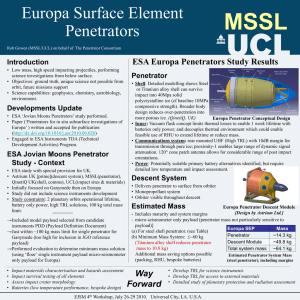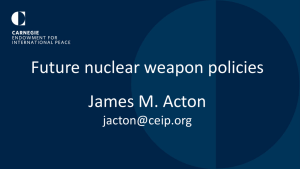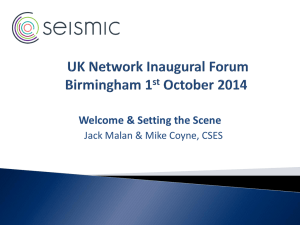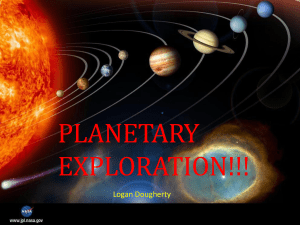What is a Space Penetrator?
advertisement
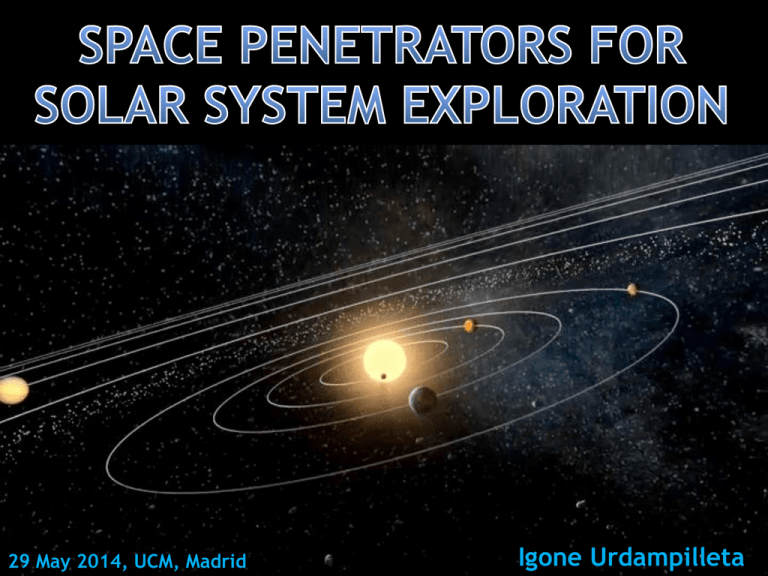
29 May 2014, UCM, Madrid Igone Urdampilleta Contents • • • • • What is a Space Penetrator? Internal Architecture Heritage Scientific Motivation Possible targets: Moon Mars Europa • Summary • References Space Penetrators 2 What is a Space Penetrator? • Low mass projectile to sample and analyze the surface and subsurface of a planet or satellite • Mass ~5-20kg • Dimensions ~0.5mx0.2m • High impact speed ~200-500m/s • Very tough ~10.000-50.000g • Penetrate surface ~0.2-3m Sand (Martian Soil) and Ice (Icy body) tests 300m/s, 24.000g Courtesy of Uk Penetratror Consortium, [1] Space Penetrators 3 Internal Architecture Radiation sensor: Subsurface dose rate, age and material decay Mass spectrometer: volatiles and biologically important species Magnetometers: possible internal ocean -Descent Camera -Auxiliary Systems -Instrumentations: 1. Environment 2. Geophysics (surface/chemistry) 3. Geophysics (interior) Batteries/RHU Accelerometers Power Communications Processing Accelerometers: Surface and Subsurface material (harness/composition) Thermal sensor: Subsurface T, regolith T and heat flow Batteries/RHU, Data logger Space Penetrators Micro-seismometers: Determine existence of interior oceans, structure and seismic activity Drill assembly: Subsurface mineralogy and material Gowen,R. et al, IPPW7, 2010 4 Heritage • Deep Space 2 and Mars 96 failed • Lunar-A (space qualified) and MoonLITE cancelled Mars 96 Deep Space 2 Courtesy of NASA [3] • • • • NASA mission launched in 1999 Mission to Mars Mars Polar Lander with 2 DS2 Reached Mars, but no comms Space Penetrators Courtesy of Russian Space [4] • • • • Russian Space Forces Mission to Mars Launched in 1996 Failed to leave Earth orbit 5 Scientific Motivation • • • • In-situ astrobiological and geophysical investigation In-situ subsurface chemical inventory Direct characterization of landing site Synergy with orbiting instrument data Advantages: • Hardly accessible sites • Simpler architecture • Cost effective: • Low mass • High instruments heritage • Similar payload for many surfaces Space Penetrators Disadvantages: • High impact survivability • Compact and low mass payload • Limited lifetime (only batteries) 6 Possible Targets • Rocky and icy bodies Space Penetrators 7 Moon: Lunar-A • • • • • Space qualified mission cancelled in 2007 Objectives: Lunar interior by seismic and heat-flow experiments Payload: 2 penetrators (near and far side) Mass:~45kg with PDS V~285m/s, Impact ~ 8000g, Depth~1-3m Space Penetrators Courtesy of ISAS/JAXA 8 Moon: MoonLITE • MoonLITE: Moon Lightweight Interior and Telecoms Experiment (UK) • Objectives: Lunar seismic environment, polar water, volatiles and ISRU • Payload: 4 penetrators • Near side Apollo landing • Two Polar regions • Far side • Duration: >1year for seismic network • Mass: ~13kg +23kg propulsion • V~300cm/s Space Penetrators Gao, Y. et al 2007 Gowen,R. et al, DOI EJSM/Laplace 9 Mars: METNET Courtesy of FMI [5] • • • • Atmospheric Mission to Mars Objectives: • Seismic activity and internal structure • Meteorological and environment study MEIGA, METNET precursor -> INTA and UCM Inflatable Entry and Descent System (16.8kg): 1. IBU (Inflatable Braking Unit) 2. AIBU (Additional IBU) Space Penetrators Courtesy of FMI [5] 10 Mars: MetNet Courtesy of FMI [5] 1. Atmospheric Instruments • MetBaro-Presure • MetHumi-Humidity • Temperature Sensor Space Penetrators 3. Composition and 2. Optical Devices Structure devices • PatCam • Magnetometer • MetSis-Irradiance • Dust Sensor 11 Europa: EJSM • EJSM: Europa-Jupiter System Mission (JUICE) • Space Penetrator Objectives: • The internal structure and its dynamics • The existence and characteristics of subsurface ocean • Astrobiology markers • Harder ice impact material, faster body • Mass: ~14.3kg +50kg PDS • Long: ~31cm Gowen,R. et al, IPPW7, 2010 Courtesy of Astrium Space Penetrators 12 Summary • Low mass projectile for planetary exploration (rocky and icy bodies) • In-situ analysis and sampling of environment and subsurface • Cost effective technology • Multi-landing sites or multi-target missions • No successful mission yet • Recent increase of Technology Readiness Level (TRL) Space Penetrators 13 References • • • • • • • • • Kato,M., Current Status of Japananise Penetrator Mission, ISAS/JAXA H Mizutani et al 2005, J. Earth Syst. Sci. 114, No. 6 Gao,Y. et al 2007, DGLR Int. Symp. “To Moon and beyond”, Bremen, Germany Gowem, R. et Penetrator Consortium, 2008, Penetrator for TSSM, TSSM Meeting, Monrovia Gowen, R. et Penetrator Consortium, 2009, An Update on MoonLITE, EGU, Viena Gowen, R. et Penetrator Consortium, 2009, Astrobiologycal Signatures with Penetrators on Europa, Biosignatures on Exoplanets Workshop, Mulhouse Gowen, R. et Penetrator Consortium, 2010, Potential Applications of Micro-Penetrators within the Solar System,IPPW7, Barcelona Skulionva, M. et al 2011, World Academic of Science, Engineering and Technology, Vol. 55 Gowen, R. et al, Surface Element Penetrators, DOI to EJSM/Laplace Space Penetrators 14 References LINKS [1] ESA: http://sci.esa.int/future-missions-office/52782-high-speedtests-demonstrate-space-penetrator-concept/ [2] UK PENETRATOR CONSORTIUM: http://www.mssl.ucl.ac.uk/ planetary/missions/ Micro_Penetrators.php [3] DS2:http://nssdc.gsfc.nasa.gov/nmc/spacecraftDisplay.do?id= DEEPSP2 [4] MARS 96: http://www.russianspaceweb.com/mars96.html [5] METNET: http://metnet.fmi.fi/index.php [6] MEIGA: http://meiga-metnet.org/ [7] EUROPA PENETRATOR:http://www.youtube.com/ watch?v=o1A04qzXCgQ Space Penetrators 15 Space Penetrators 16 Space Penetrator Descent Sequence 1. Descent Module release from Orbiter Spin-Down 2. Cancel orbital velocity 3. Re-orient 4. PDS (Penetrator Delivery System) separation from penetrator Gowen,R. et al, DOI EJSM/Laplace Space Penetrators Delivery sequence courtesy SSTL Reorient Penetrator Separation 5. PDS fly away prior to surface Impact 6. Operate from below surface Moon Characteristics: Telluric satellite No atmosphere, no plate tectonics >30.000 impact craters >1km Dark zones (maria): - craters, younger, 15% area • Bright zones (terrae): + craters, older, 85% area • • • • Science Objectives (Gao,Y. et al 2007) : • Volatiles in the shadowed lunar craters • Lunar seismology: interior and core • In-situ resources, ISRU (water ice/radiation/quakes) • Planetary penetrator demonstrator Space Penetrators 18 Mars Characteristics: Telluric planet Atmosphere No plate tectonics Changing topography due to seasonal variation and dust storms • Polar ice caps • • • • Science objectives: • • • • Seismic activity and internal structure Astrobiology markers from depths >2m Meteorological and environment study Possible landing sites: • Polar caps • <40º for seismic network Space Penetrators 19 Europa Characteristics: • • • • • • • Water-icy satellite Atmosphere-trace Oxygen Strong tidal forces Lower slopes/smoother surface Less regolith (young) Possible subsurface ocean Habitable? Life? Science objectives (Gowen,R. et al, DOI EJSM/Laplace) : • • • • The internal structure and its dynamics The existence and characteristics of subsurface ocean Bio-signatures and Environment in near-surface Synergy data with remote sensing Space Penetrators 20
